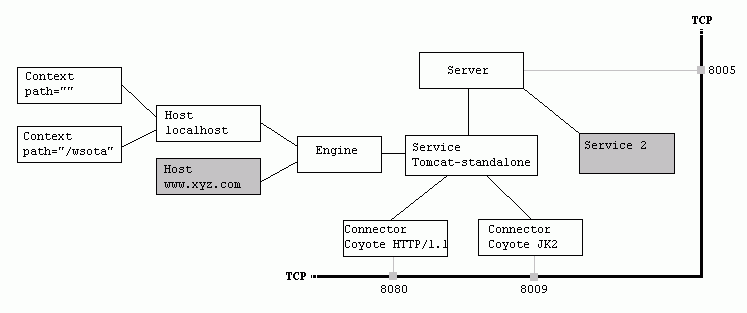Home > Article > Backend Development > Detailed explanation of Server.xml content [Tomcat]
Structural diagram of Tomcat Server

##This file describes how to start Tomcat Server
| Element name | Attribute | Explanation |
| server | port | Specify a port, which is responsible for listening and closing tomcat request |
| shutdown | Specifies the command string sent to the port | |
| service | name | Specify the name of the service |
| Connector (representing the connection between the client and the service) | port | #Specify the server to create The port number, and listen for requests from the client on this port |
| minProcessors | Processors created when the server starts Number of threads requested | |
| ##maxProcessors | Maximum number of threads that can be created to process requests | |
| enableLookups | If true, you can get the actual host name of the remote client by calling request.getRemoteHost() to perform a DNS query. If it is false, DNS query will not be performed, but its ip address will be returned. | |
| redirectPort | The specified server is processing The port number to redirect after receiving an SSL transfer request when http request | |
| acceptCount | Specify when all can When all the threads used to process requests are used, the number of requests that can be placed in the processing queue. Requests exceeding this number will not be processed | |
| connectionTimeout | Specify the number of timeouts (in milliseconds) | |
| Engine (indicates request processing in the specified service machine, receives and processes requests from Connector) | defaultHost | Specifies the default host name for processing requests, which is at least the same as The name attribute value of a host element is the same |
| Context (indicating a web application, usually a WAR file. For specific information about WAR, see the servlet specification) | docBase | The path of the application or the path where the WAR file is stored |
| path | represents the prefix of the URL of this web application, so the requested URL is http://localhost:8080/path/**** | |
| reloadable | This attribute is very important. If it is true, tomcat will automatically detect the application's /WEB-INF/lib and changes to the /WEB-INF/classes directory to automatically load new applications. We can change applications without restarting tomcat | |
| host (Indicates a virtual host) | name | Specify the host name |
| appBase | The application base directory, which is the directory where the application is stored | |
| If it is true, tomcat will automatically decompress the WAR file, otherwise it will not decompress and run the application directly from the WAR file | ||
| className | Specifies the class name used by the logger. This class must implement org.apache. catalina.Logger interface | |
| Specify the prefix of the log file | ||
| suffix | Specify the suffix of the log file | |
| timestamp | If it is true, the time must be added to the log file name, as in the following example: localhost_log.001-10-04.txt | |
| Realm (represents the database that stores usernames, passwords and roles) | className | Specifies the class used by Realm Name, this class must implement the org.apache.catalina.Realm interface |
| Valve (the function is similar to Logger, and its prefix and suffix attribute explanations are the same as those in Logger ) | className | Specify the class name used by Valve. For example, use the org.apache.catalina.valves.AccessLogValve class to record the application's Access information |
| directory | Specify the location where the log file is stored | |
| pattern | has two values, the common mode records the remote host name or IP address, user name, date, the string requested in the first line, and the HTTP response Code, number of bytes sent. The combined method records more values than the common method |
注意:一个“Server”自身不是一个“Container”(容器),因此在这里你 不可以定义诸如“Valves”或者“Loggers”子组件 –>
 在端口8005处等待关闭命令
在端口8005处等待关闭命令  如果接受到”SHUTDOWN”字符串则关闭服务器
如果接受到”SHUTDOWN”字符串则关闭服务器  –>
–> 
测试: telnet localhost 8005 输入:SHUTDOWN 结果:关闭tomcat
1>className指定实现org.apache.catalina.Server接口的类.默认值为org.apache.catalina.core.StandardServer 2>port指定Tomcat监听shutdown命令端口.终止服务器运行时,必须在Tomcat服务器所在的机器上发出shutdown命令.该属性是必须的. 3>shutdown指定终止Tomcat服务器运行时,发给Tomcat服务器的shutdown监听端口的字符串.该属性必须设置
注意:一个“Service”自身不是一个容器,因此,在这个级别上你不可定义 诸如“Valves”或“Loggers”子组件。 –>
 Service是一组Connector的集合
Service是一组Connector的集合  它们共用一个Engine来处理所有Connector收到的请求
它们共用一个Engine来处理所有Connector收到的请求  –>
–>
1>className 指定实现org.apahce.catalina.Service接口的类.默认为org.apahce.catalina.core.StandardService 2>name定义Service的名字
第一个Connector元素定义了一个HTTP Connector,它通过8080端口接收HTTP请求;第二个Connector元素定义了一个JD Connector,它通过8009端口接收由其它服务器转发过来的请求.
1>className指定实现Engine接口的类,默认值为StandardEngine 2>defaultHost指定处理客户的默认主机名,在
在
的相对目录.如果没有此项,默认 为/webapps. 它将匹配请求和自己的Context的路径,并把请求转交给对应的Context来处 理 autoDeploy:如果此项设为true,表示Tomcat服务处于运行状态时,能够监测appBase下的文件,如果有新有web应用加入进来,会自运发布这个WEB应用 unpackWARs:如果此项设置为true,表示把WEB应用的WAR文件先展开为开放目录结构后再运行.如果设为false将直接运行为WAR文件 alias:指定主机别名,可以指定多个别名 deployOnStartup:如果此项设为true,表示Tomcat服务器启动时会自动发布appBase目录下所有的Web应用.如果Web应用 中的server.xml没有相应的 元素,将采用Tomcat默认的Context –>
在
Tomcat Server处理一个http请求的过程
假设来自客户的请求为:
localhost:8080/wsota/wsota_index.jsp
1) 请求被发送到本机端口8080,被在那里侦听的Coyote HTTP/1.1 Connector获得 2) Connector把该请求交给它所在的Service的Engine来处理,并等待来自Engine的回应 3) Engine获得请求localhost/wsota/wsota_index.jsp,匹配它所拥有的所有虚拟主机Host 4) Engine匹配到名为localhost的Host(即使匹配不到也把请求交给该Host处理,因为该Host被定义为该Engine的默认主机) 5) localhost Host获得请求/wsota/wsota_index.jsp,匹配它所拥有的所有Context 6) Host匹配到路径为/wsota的Context(如果匹配不到就把该请求交给路径名为”"的Context去处理) 7) path=”/wsota”的Context获得请求/wsota_index.jsp,在它的mapping table中寻找对应的servlet Context匹配到URL PATTERN为*.jsp的servlet,对应于JspServlet类 9) 构造HttpServletRequest对象和HttpServletResponse对象,作为参数调用JspServlet的doGet或doPost方法 10)Context把执行完了之后的HttpServletResponse对象返回给Host 11)Host把HttpServletResponse对象返回给Engine 12)Engine把HttpServletResponse对象返回给Connector 13)Connector把HttpServletResponse对象返回给客户browser
The above is the detailed content of Detailed explanation of Server.xml content [Tomcat]. For more information, please follow other related articles on the PHP Chinese website!